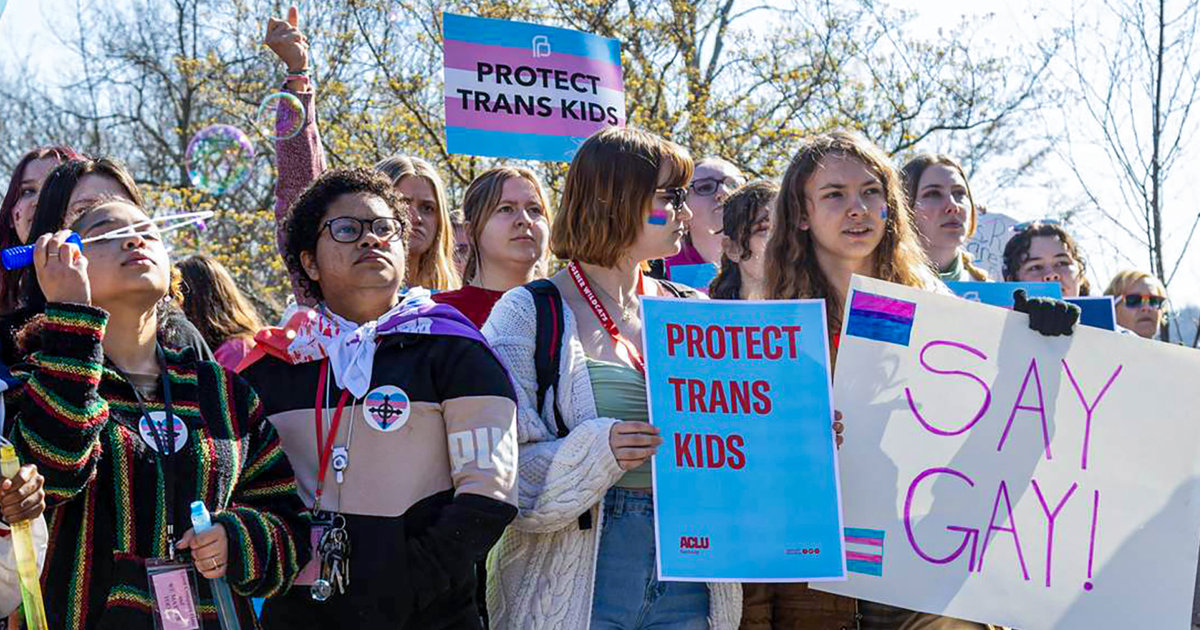About 3.3% of high school students identify as transgender and another 2.2% have at some point questioned if they were one, according to data from the Centers for Disease Control and Prevention.
The data, which was collected as part of the CDC’s national 2023 Youth Risk Behavior Survey of more than 20,000 students in public and private high schools in the United States, provides the first nationally representative estimates of trans identity among students.
It found that trans and questioning students more often experienced violence, poor mental health, suicidal thoughts, unstable housing and less school connectedness than their peers who are cisgender, meaning they identify with the sex they were assigned at birth.
About one-quarter, 26%, of trans and questioning students attempted suicide in the past year compared with 11% of cisgender female students and 5% of cisgender male students, the CDC found. One in 10, or 10.3%, of trans students said they had a suicide attempt treated by a doctor or nurse in the past 12 months, compared to 3.7% of questioning students, 2.6% of cisgender female students and 1% of cis male students.
“That level of distress and that level of experience of stigma and violence is really heartbreaking and is something we must address,” Kathleen Ethier, director of the division of adolescent and school health for the CDC, said.
Trans students were also more likely to report being bullied at school, consistent with previous research on the subject. An estimated 40% of trans and questioning students said they were bullied at school, compared to 20.3% of cis female students and 14.8% of cis male students.
Trans students were also the most likely, at 71.9%, to report persistent sadness or hopelessness — a marker for experiencing depressive symptoms, according to the CDC — in the past 12 months, with questioning students at 68.9%, cisgender female students at 50.5% and cisgender male students at 26%.
Significantly more trans students and questioning students, at 10.7% and 10%, respectively, reported experiencing unstable housing in the past 30 days, compared to 1.8% of cisgender female students and 2.1% of cisgender male students.
Ethier said past research has shown that LGBTQ-inclusive school policies help to reduce bullying and negative mental health outcomes.
“We’ve done studies that have shown that schools that put a set of LGBTQ+ policies and practices in place that includes having a GSA, having anti-harassment policies that are enforced in schools, providing information and training to teachers and other school staff, identifying safe spaces for LGBTQ+ students — when schools do those things, the health and well being and the mental health of LGBTQ students improves, but also the health and well being of heterosexual students in those schools improves as well,” Ethier said.
She added, “Oftentimes this is approached as a zero sum game, that if you are focused on supporting one group of young people that you are not supporting another group of young people, and what we’ve seen in our research is that when you address the needs of the most vulnerable youth, all youth benefit.”
The new CDC data aligns with previous research that has found worse mental health among trans and nonbinary youths, in part due to a wave of legislation targeting their participation in school sports and access to transition-related medical care and identity documents that reflect their gender identities, among other areas of their lives.
Half of states have passed laws prohibiting trans students from playing sports on the teams that align with their gender identities, and 26 states have enacted measures that bar them from receiving certain types of transition-related health care, such as puberty blockers, hormone therapy or surgeries.
A study published in the journal Nature Human Behavior last month by The Trevor Project, a youth suicide prevention and crisis intervention organization, found that such laws made trans and nonbinary youths more likely to attempt suicide.
The Trevor Project compared suicide-related outcomes for trans and nonbinary young people in 19 states that passed laws targeting transgender people to the outcomes for trans and nonbinary youths in states that did not enact any such laws. It established the first causal link between such laws and an increase in suicide attempts, finding that the measures caused up to a 72% increase in suicide attempts among trans and nonbinary youths.
Ronita Nath, vice president of research at The Trevor Project and one of the authors of that research, said the CDC’s new data “confirm what we have long known to be true: Transgender young people are disproportionately impacted by a number of health disparities including sadness, bullying and suicide risk, compared to their peers.”
“It is crucial to clarify that these young people are not inherently prone to these negative mental health outcomes, but rather, placed at higher risk because of how they are mistreated and stigmatized by others,” Nath said. “The figures reported by the CDC are harrowing, and indicate that much remains to be done to support transgender young people’s health and safety in the U.S., especially as we’re witnessing another record-breaking year of anti-transgender legislation.”
She added that she’s grateful to see that trans young people are finally being counted by the Youth Risk Behavior survey for the very first time this year and urged public health institutions to continue collecting similar data.
If you or someone you know is in crisis, call or text 988 to reach the Suicide and Crisis Lifeline or chat live at 988lifeline.org. You can also visit SpeakingOfSuicide.com/resources for additional support.
If you are an LGBTQ young person in crisis, feeling suicidal or in need of a safe and judgment-free place to talk, call the TrevorLifeline now at 1-866-488-7386 or the Rainbow Youth Project at 1-317-643-4888.

Leave a Reply